

The 'Space Architects' of Mars. Food for a Mars Mission - How to Feed Astronauts on a 3-5 year Mars Mission? Solving world hunger: Food made from electricity and thin air might be the solution - TomoNews. NASA is growing a Martian garden to prepare for life on Mars. As many of us witnessed in director Ridley Scott's sci-fi drama "The Martian," the soil of Mars is devoid of the organic nutrients otherwise vital to support plant life.
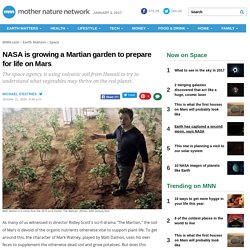
To get around this, the character of Mark Watney, played by Matt Damon, uses his own feces to supplement the otherwise dead soil and grow potatoes. But does this science match up with how the first Mars farmers might actually introduce agriculture to the red planet? In addition to experimenting with crops grown in space, NASA is beginning to trial "Martian Gardens" to figure out the kinds of vegetables that might tolerate soil sourced from the red planet. "Soil, by definition, contains organics; it has held plant life, insects, worms.
Mars doesn't really have soil," Ralph Fritsche, the senior project manager for food production at Kennedy Space Center, said in a news release. What's for Dinner on Mars? - Dr. Jean Hunter - 14th International Mars Society Convention. Webinar: How Crops Benefit From Robust Soil Microbial Populations. What's Up With Your Gut Microbiome? Symbioses Are Way More Complex Than You Think! Vitamins’ Old, Old Edge. It took hundreds of millions of years for plants to become such proficient vitamin C manufacturers, but vitamin production can change in far less time.
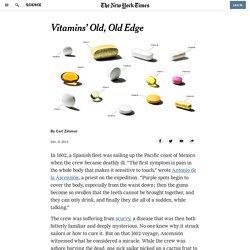
Our own ancestors needed just thousands of years to alter their production of vitamin D. When humans left equatorial Africa and spread to higher latitudes, the sun was lower in the sky and supplied less ultraviolet light. By evolving lighter skin, Europeans and Asians were able to continue making a healthy supply of vitamin D. Aside from vitamins D and K, we humans can’t make any of the vitamins we need to stay healthy. In some cases, our ancestors could make them, but lost that ability. Scurvy: Prevention with Vitamin C. ❌ IODINE: Essential or Dangerous? Why You Need It? How Much? ❌ Micronutrients : basic knowledge. News Story - SpaceRef Canada. When humans made the transition from the nomadic life of the hunter-gather to become inhabitants of communities, they did so by means of cultivating plants and domesticating animals.

Soon, agriculture was born. Armed with the ability to stay in one place - humans now had the time and luxury to accumulate things - with knowledge being the foremost. At some point "civilization" emerged as a result. As human communities spread out across our planet, these two learned behaviors have become ever more pliant, allowing previously uninhabitable regions to become habitable. Each new challenge spurred the development of new solutions. Students Win NASA Contest With a Greenhouse Designed for Mars. Greek students have attempted to take one step forward in the quest to make Mars more hospitable: They created a self-supporting greenhouse that grows spinach and is brilliantly named Popeye.
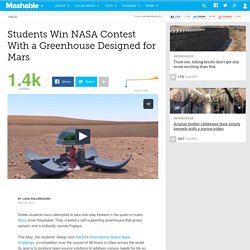
This May, the students' design won NASA's International Space Apps Challenge, a competition over the course of 48 hours in cities across the world. Mars Greenhouse Dome - FinalProjects. Introduction Figure 1: Diagram of a Environmental Factors for a Projected Greenhouse Dome[1] Life on Mars will be difficult to sustain by just migrating to the planet alone.

Although it contains carbon, nitrogen, hydrogen, and oxygen all in biologically ready forms[2], it is still a highly hostile environment for sustaining the life of human beings. There is, however, an abundance of minerals and Earth-like qualities, such as hydrolic and volcanic processes[2] that make the idea of colonizing Mars alluring. In order to circumvent the necessity of underground housing to avoid radiation exposure, greenhouse domes can be created on the surface for civilization and agricultural needs. Accomplishing the growth of crop for future habitation will be done through harvesting solar power and using it to generate power for the greenhouse dome.
MARS GREENHOUSE. Greenhouses for Mars. Greenhouses for Mars When humans go to the Moon or Mars, they'll probably take plants with them.
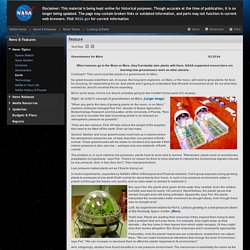
NASA-supported researchers are learning how greenhouses work on other planets. Mars Greenhouse Projects - Dr. Melanie Correll - 14th International Mars Society Convention. Full Scale Lunar Greenhouse Prototype. ICES 2014 246. Furfaro Mars Lunar Greenhouse M LGH at the University of Arizona Status and Path Forward. Controlled Environment Agriculture Center. The Prototype Lunar Greenhouse (LGH) is equipped as a Bioregenerative Life Support System (BLSS) through the design and construction of an innovative hydroponic plant growth chamber.
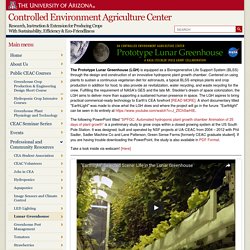
Centered on using plants to sustain a continuous vegetarian diet for astronauts, a typical BLSS employs plants and crop production in addition for food, to also provide air revitalization, water recycling, and waste recycling for the crew. Fulfilling the requirement of NASA's GES and the late Mr. Steckler's dream of space colonization, the LGH aims to deliver more than supporting a sustained human presence in space. The LGH aspires to bring practical commerical-ready technology to Earth's CEA forefront [READ MORE]. A short documentary titled "EarthLight" was made to show what the LGH does and where the project will go in the furure. Take a look inside via webcam!
UA-CEAC Prototype Lunar Greenhouse. NASA developing food bars light enough for astronauts to bring to Mars. Here’s the good news: We’re going to Mars!
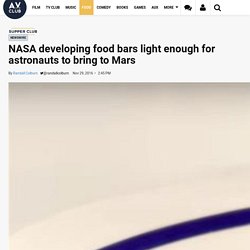
Here’s the bad news: Food is too heavy! In 2021, NASA plans to launch the Orion spacecraft on a six-month journey to the Red Planet. That will require a lot of heavy, heavy fuel, meaning scientists are currently looking for ways to shed extra weight from the spacecraft. MARS: How to Survive on Mars. Top 10 Healthiest Vegetables In The World. NASA Tests Its Largest Plant Chamber Prototype Ahead Of Space Station Delivery. Growing plants in space is hard, for reasons more or less obvious.
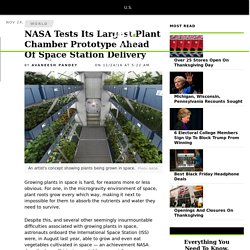
For one, in the microgravity environment of space, plant roots grow every which way, making it next to impossible for them to absorb the nutrients and water they need to survive. Despite this, and several other seemingly insurmountable difficulties associated with growing plants in space, astronauts onboard the International Space Station (ISS) were, in August last year, able to grow and even eat vegetables cultivated in space — an achievement NASA described as a “historic vegetable moment.” Those vegetables — a crop of red romaine lettuce — were grown using the “Veggie” plant growth system on the ISS. The system, installed on the orbiting space lab in 2014, uses a series of red, blue and green LEDs to stimulate plant growth from “pillows” containing seeds, fertilizers and nutrients.
“The unit is a closed-loop system with a controlled environment than can house large plants. Feasibility of a Mars Surface Inflatable Greenhouse: Availability of ... Constanza Cuneo - Hydroponics - 19th Annual International Mars Society Convention. Imagineering on Mars - Making Food to Eat on Mars(Imagineering E-Zine) Human and Plant Needs - Welcome to Mars. Lemnoideae - Wikipedia. Weed Of Ducks, or water lens, are flowering aquatic plants which float on or just beneath the surface of still or slow-moving bodies of fresh water and wetlands.
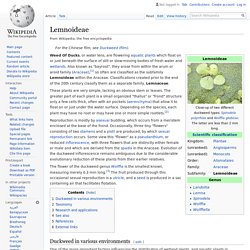
Also known as "bayroot", they arose from within the arum or aroid family (Araceae),[1] so often are classified as the subfamily Lemnoideae within the Araceae. Classifications created prior to the end of the 20th century classify them as a separate family, Lemnaceae. These plants are very simple, lacking an obvious stem or leaves. The greater part of each plant is a small organized "thallus" or "frond" structure only a few cells thick, often with air pockets (aerenchyma) that allow it to float on or just under the water surface.
Depending on the species, each plant may have no root or may have one or more simple rootlets.[2] Duckweed in various environments[edit] Taxonomy[edit] Duckweeds belong to the order Alismatales and the Araceae family. Farming on Mars - What the First Settlers Will Need to Know. Now that we have an idea of what we might want to grow and how we could grow it, let's take a look at the physical side of our farm on Mars. Growing food on Mars presents several significant challenges. While research on the International Space Station suggests plants can grow in microgravity, we don't really know how the reduced gravity on Mars might affect Earth crops. Several issues need to be studied and explored, most of which can be done, and in some cases has already been done, here on Earth, including: lightingatmospheric pressureCO2 content, oxygen levels, andradiation protection Lighting Mars surface only receives about half the sunlight Earth does, and any pressurized greenhouse enclosure will block the sunlight even more.
Constanza Cuneo - Hydroponics - 19th Annual International Mars Society Convention. A New Form of Life Takes Root on the ISS. Earthrise - Japan's Future Farms. This Farm of the Future Uses No Soil and 95% Less Water. This computer will grow your food in the future. How we can make crops survive without water. Square Roots. Impossible Foods Meatless Burger. Large-scale cricket flour production - Cricket Lab.
Why companies are mass-producing edible insects. Are Microalgae The Next Generation Food of the Future? Ecoduna-new micro-algae tech produces super food from waste [Special Report] Researcher Engineers Protein-Rich Algae as Meat, Soy Substitute. Algae flour. Hemp Spirulina Superfood Squares - Recipe & Tips. The Living Soil: How Unseen Microbes Affect the Food We Eat (360 Video)
5 Common Groceries Made From Microorganisms. #Future-ready: Harnessing Plant-Microbe Systems. Microorganisms and their use in Industry -National 4. Introducing The Human Gut Microbiome. What's Up With Your Gut Microbiome? Gut Microbial Metabolism and Food Constituents - Johanna Lampe.